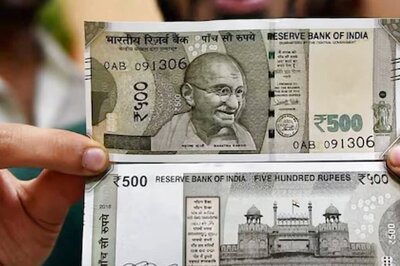
views
Rikuzentakata: A widening cloud of radiation on Tuesday added to the misery of millions of people in Japan’s devastated northeast, already short of water and food and trying to keep warm in near-freezing temperatures.
As bodies washed up on the coast from Friday’s devastating earthquake and tsunami, injured survivors, children and elderly crammed into makeshift shelters, often without medicine. By Monday, 550,000 people had been evacuated after the cataclysmic events that killed at least 10,000.
Panic swept Tokyo after a rise in radioactive levels around an earthquake-hit nuclear power plant north of the city, causing some to leave the capital and others to stock up on food and supplies.
The humanitarian crisis was unfolding on multiple fronts – from a sudden rise in orphaned children to shortages of water, food and electricity to overflowing toilets in packed shelters and erratic care of traumatised survivors.
With homes levelled, towns washed away and jobs gone, many were wondering if they stay and rebuild.
“We survived, but what are we supposed to do from here?” said Sachiko Sugawara, 63, now living at one of the shelters.
Bodies were stacking up at morgues and the chronically ill were running out of medicine.
“People are exhausted both physically and mentally,” said Yasunobu Sasaki, the principal of a school converted into a shelter in Rikuzentakata, a nearly flattened village of 24,500 people in far-northern Iwate prefecture.
Local officials have lost contact with about 30,000 people, according to a survey by Kyodo News, raising concerns of a dramatic increase in the number of dead as authorities grapple with Japan’s biggest emergency since World War Two.
Roads and rail, power and ports have been crippled across much of the northeast of Japan’s main island Honshu, hampering relief efforts. The government has mobilised 100,000 soldiers and more than 100 countries have offered assistance.
But the increased radiation caused the US Navy to temporarily pull an aircraft carrier group away from the coast, and major international relief agencies have been kept out of the radiation hot zones.
“These latest developments will obviously make the humanitarian effort more difficult,” said Francis Markus, a spokesman for the International Federation of Red Cross.
The Japanese Red Cross has deployed about 90 medical teams who are trying to provide the basics in care for 430,000 in remote towns spread along the coast.
“The tsunami engulfed half the town and many lie shivering uncontrollably under blankets. They are suffering from hypothermia having been stranded in their homes without water or electricity,” said Patrick Fuller of the International Federation of Red Cross, in a memo written from the tsunami-hit coastal city Ishinomaki.
Hundreds of foreign rescue workers are assisting quake and tsunami victims but the United Nations does not plan to mount a bigger relief operation unless requested, UN aid officials said on Monday.
All along the ravaged northeastern coast, there were similar scenes of desperation and destruction. The wall of water transported homes inland, swept ships into fields, upended cars and left trains scattered across fields like toys.
Toshiyuki Suzuki, 61, has a heart pacemaker and takes seven kinds of medicine a day. He lost all of them when the waves swept away his home, along with his 91-year-old father and 25-year-old son.
Emergency workers have so far rescued 15,000 people and about 550,000 had been evacuated by Monday to about 2,600 shelters in six prefectures, Kyodo said.
Snow or rain is expected on Wednesday in some regions, adding urgency to relief efforts.




















Comments
0 comment